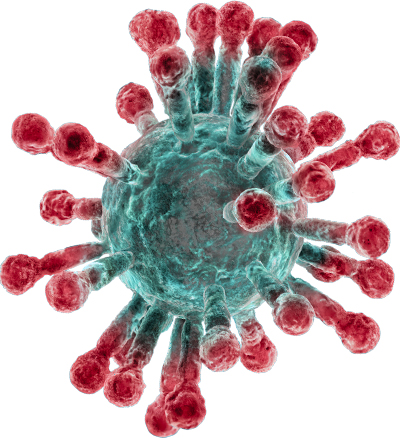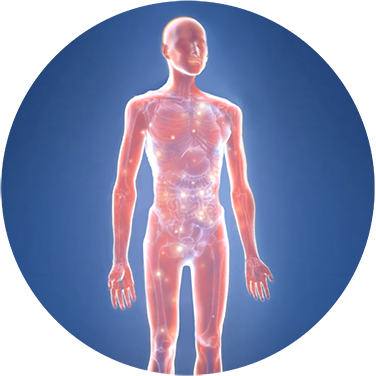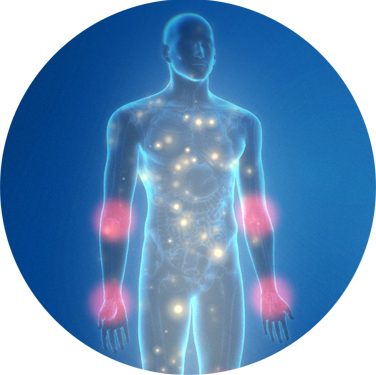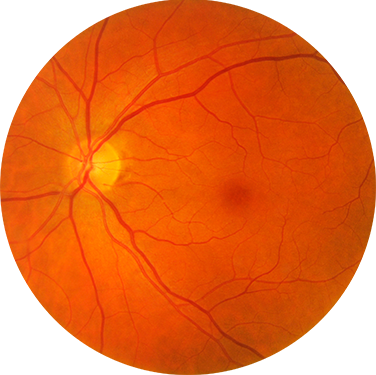Powering Relentless Science™
EOM’s pipeline is built on novel compounds with the potential to transform therapeutic paradigms and potentially improve quality of life in patients suffering from debilitating and sometimes deadly diseases, including infectious diseases; autoimmune diseases including rheumatoid arthritis; and cachexia associated with AIDS and cancer.

COVID-19 is a highly infectious and potentially fatal disease, causing over 3.4 million deaths and over 167 million cases worldwide.1
Research shows that cytokine storms are highly correlated with mortality in COVID-19.2 Aggressive inflammatory responses such as cytokine storms can lead to acute respiratory distress syndrome (ARDS), which is a cause of death in 70% of fatal COVID-9 cases.3

Cancer cachexia affects approximately 50% of all cancer patients.4
Cachexia is a wasting syndrome that causes loss of weight, body fat, muscle mass, and appetite due to a chronic disease, such as cancer. It results in weakness, fatigue, malnourishment, and can be life-threatening.5
Cancer cachexia is caused by a combination of decreased nutritional intake and altered metabolism and is defined as ongoing loss of skeletal muscle mass that cannot be reversed by conventional nutritional support. It is characterized by progressive functional impairment and contributes to more than 20% of cancer deaths. Since around 50% of patients with malignant disease cannot be cured and more than 80% of advanced cancer patients experience cachexia, the toll of this condition is severe both for society and the individual patient.6 The pathogenesis of cancer cachexia is highly dependent on the patient’s immune response. Inflammatory cytokines and procachectic factors induce muscle degradation even in the face of adequate nutrition.The prevalence of cachexia is as high as 87% in patients with pancreatic and gastric cancer, 61% in patients with colon, lung, and prostate cancer and non-Hodgkin lymphoma, and 40% in breast cancer, sarcoma, leukemia, and Hodgkin lymphoma.7
There are no approved cancer cachexia therapies. Large companies are investing in early stage trials, thereby supporting the therapeutic need and value of treatment interventions.

Rheumatoid arthritis (RA) is a debilitating chronic autoimmune disease that affects the joints, connective tissues, muscle, tendons, and fibrous tissue, and causes pain and deformity.
The World Health Organization estimates more than 23 million people, mostly women, live with RA.8

Retinal diseases, including retinal tear, retinal detachment, diabetic retinopathy, epiretinal membrane, macular hole, macular degeneration, and retinitis pigmentosa9, affect the vital tissue of the eye and can lead to blindness.
Age-Related Macular Degeneration (AMD)
Age-related macular degeneration (AMD) is an eye disease that can blur the sharp, central vision you need for activities like reading and driving. “Age-related” means that it often happens in older people. “Macular” means it affects a part of your eye called the macula. AMD is a common condition — it’s a leading cause of vision loss for people age 50 and older. AMD doesn’t cause complete blindness but losing your central vision can make it harder to see faces, drive, or do close-up work like cooking or fixing things around the house.11
By 2050, the estimated number of people with AMD in the U.S. is expected to double from 2.07 million (2010) to 5.44 million.12 There is no treatment for dry macular degeneration, but certain vitamin and mineral supplements may delay progression of the disease.13
Wet macular degeneration is often treated by eye injections of anti-VEGF medicines, which inhibit the abnormal growth of blood vessels. A type of laser treatment called photodynamic therapy also can be used to help break down the extra blood vessels in the back of the eye.14
Diabetic Retinopathy (DR):
Diabetes is the leading cause of new cases of blindness in adults. About 1 in 3 people with diabetes have Diabetic Retinopathy, affecting almost one-third of adults over age 40 years with diabetes, and more than one-third of AfricanAmericans and Mexican Americans.15
Diabetic retinopathy affects 7.7 million Americans, and that number is projected to increase to more than 14.6 million people by 2030.16 The most common diabetic eye disease and a leading cause of blindness in American adults, diabetic retinopathy is caused by changes in the blood vessels of the retina due to excess sugar in the bloodstream.17
Diabetic retinopathy may be treated by shrinking abnormal blood vessels in the eye with laser therapy, by surgically evacuating and replacing fluid in the eye (vitrectomy), or by injecting anti-VEGF medicines into the eye.18
1
World Health Organization Coronavirus Disease (COVID-19) Dashboard. Available here.
2
Fajgenbaum DC, June CH. Cytokine Storm. NEngl J Med. 2020;383(23):2255-2273. doi:10.1056/NEJMra2026131
3
Hojyo S, Uchida M, Tanaka K, et al. How COVID-19 induces cytokine storm with high mortality. Inflamm Regen. 2020;40:37. Published 2020 Oct 1. doi:10.1186/s41232-020-00146-3
4
Zhong X, Zimmers TA. Sex Differences in Cancer Cachexia. Curr Osteoporos Rep. 2020;18(6):646-654. doi:10.1007/s11914-020-00628-w
5
OncoLink. Support / Nutrition and Cancer / Nutrition During and After Cancer Treatment. Available here.
6
7
Prognostic effect of weight loss prior to chemotherapy in cancer patients. Eastern Cooperative Oncology Group. Dewys WD, Begg C, Lavin PT, Band PR, Bennett JM, Bertino JR, Cohen MH, Douglass HO Jr, Engstrom PF, Ezdinli EZ, Horton J, Johnson GJ, Moertel CG, Oken MM, Perlia C, Rosenbaum C, Silverstein MN, Skeel RT, Sponzo RW, Tormey DC Am J Med. 1980 Oct; 69(4):491-7.
8
GlobalRA Network. Available here.
9
Mayo Clinic. Retinal Diseases. Accessed April 29, 2021. Available here.
10
Mayo Clinic. Retinal Diseases. Accessed April 29, 2021. Available here.
11
National Eye Institute. National Institute of Health. Available here.
12
National Institutes of Health / National Eye Institute. Age-Related Macular Degeneration. Accessed April 29, 2021. Available here.
13
National Institutes of Health / National Eye Institute. Age-Related Macular Degeneration. Accessed April 29, 2021. Available here.
14
National Institutes of Health / National Eye Institute. Age-Related Macular Degeneration. Accessed April 29, 2021. Available here.
16
National Eye Institute. National Institute of Health. Available here.
17
National Institutes of Health / National Eye Institute. Diabetic Retinopathy Data and Statistics. Accessed April 29, 2021. Available here.
18
National Institutes of Health / National Eye Institute. Diabetic Retinopathy Data and Statistics. Accessed April 29, 2021. Available here.